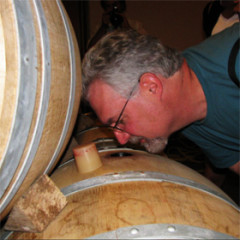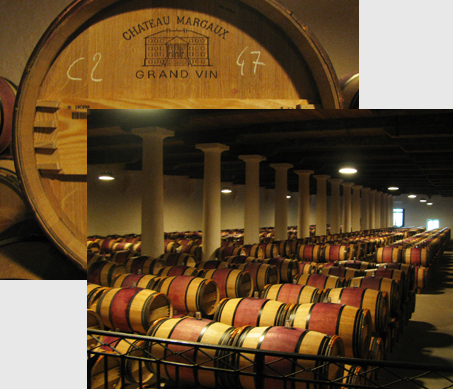Can’t See The Forest For The Lees – Of Oak, Wine & Bacon.
Chapter Thirteen, Part Two.
“Oak is here and it will be with us for at least the remainder of the current generation—a generation that has been carefully taught that if a little oak is a good thing, a lumber factory is wonderful.” Dan Berger
Wood barrels have been used by the wine trade for over two thousand years, but just over a century ago astute winemakers recognized the transformative effect that oak has on wine and they began to look at barrels as more than storage vessels. Over time, patient old-world vignerons learned that the species of oak, outdoor seasoning, the degree of toasting over fire and the time spent in barrel all bear heavily on how oak “flavors” wine. They learned that one type of oak may add spicy allspice and cinnamon nuances while another may add a smoky bacon flavor. I don’t know about you but I’d eat my left foot if it had a smoky bacon flavor.
As Old World winemakers grew to understand oak’s flavoring capabilities they gradually incorporated its use into the traditional winemaking practices handed down by their fathers. Years later, New World winemakers felt the need to rediscover, reinvent, and otherwise push the envelope regarding  oak’s potent possibilities. Through much trial and even more error, winemakers learned that oak is a powerful ingredient that greatly influences the outcome of the finished wine. They came to realize that massaging wine with oak is like adding a subtle layer of make-up to a beautiful woman. Unfortunately many winemakers still apply oak like Tammy Faye Bakker applied mascara.
oak’s potent possibilities. Through much trial and even more error, winemakers learned that oak is a powerful ingredient that greatly influences the outcome of the finished wine. They came to realize that massaging wine with oak is like adding a subtle layer of make-up to a beautiful woman. Unfortunately many winemakers still apply oak like Tammy Faye Bakker applied mascara.
The flavors and textures created when wine is matured in barrel vary according to the type of oak. The most common species used in winemaking are Quercus Robur and Quercus Petraea from France and an American species known as Quercus Alba (no relationship to Jessica
Alba). French oak is a tight-grained wood while American oak possesses an open grain – but a narrow-mind.
Flavors derived from open-grained oak leach into wine more aggressively than those from tight-grained species. The formation of grain also dictates how an oak tree must be cut into staves, as the wrong cut will result in a barrel with more leaks than the Nixon administration.
American oak is economically quarter-sawn to insure a watertight seal, but the nature of the grain makes it easy to over-extract or “over-oak” maturing wine. Modern coopers are developing methods to curtail the potency of American oak and as a result its use is on the rise worldwide. It has been a hallmark of Spanish wine for the past century and is also widely used in Australia and California.
American oak has a sweet palate presence, imparts strong aromatics, and generates a softer, fleshier texture or mouth feel than tight-grained species. While different species may impart similar aromas and flavors, coconut and dill are two aromatic traits that are unique to American oak. Other common American oak characteristics include vanilla, roasted coffee and smokiness. Despite American oak’s recent inroads, French oak still reigns supreme in the eyes of most winemakers. They feel American oak is nothing more than a cheap alternative to French oak, a brilliant conclusion given its lower cost.
French oak, which must be split along the grain to remain impermeable, impacts wine less aggressively than American oak. The restrained nature of French oak gives winemakers better control and generally results in a more reserved style of wine. French oak has less influence on the aromatics and contributes more wood tannins, which in turn adds more structure to the mouth feel or mid-palate.
French oak is likely to impart subtly nuanced qualities of cinnamon, allspice, chocolate, and cedary cigar-box. It may also manifest itself as custard, crème brulee, buttered popcorn or butterscotch, which are collectively known as date night at the Carters.
There are some esters, such as vanilla, that are common to both French and American oak, however, I find subtle differences in the vanillin traits transmitted by the different species. The vanillin shadings of French oak seem more akin to vanilla bean than the sweet vanilla extract, sugar cookie-like flavors common to American oak.
French oak, so vital to the character of French wines today, was not always

While visiting Chateau Cantenac in St.-Emilion, our host Johan Roskam-Brunot challenged me to identify the lone Hungarian oak barrel hidden among the French barrels by smell alone.
the wood of choice for French vintners. Oak from Hungarian forests was once preferred over French oak, possibly because it imparts a smoother texture to the finished wine.¹ Centuries of supply disruption due to political strife and war led the French to find suitable substitutes in their own forests. However, late in the 20th century the iron curtain lifted and once again Hungarian oak usage began to rise.
Hungarian oak is a tight-grained wood that shares many attributes with French oak. One trait they do not share is the cost. Hungarian oak is considerably cheaper than French oak, and is a useful alternative for wineries on a budget. That is not to say Hungarian oak is not also prized for its ability to impart unique flavors that include clove, cinnamon, butterscotch, banana, tapioca, black pepper, roasted coffee, and smoky bacon (and you know how I feel about bacon).
Fruit flavors are born from the grape (with a little help from yeast). The tart apple flavors found in wine for example, come mainly from malic acid, an acid present in both grapes and apples. Fermentation also influences the flavor of wine. Diacetyl is a byproduct of malolactic fermentation, a process that converts the aforementioned malic acid into creamier lactic acid. It’s the component that gives butter and some Chardonnays their pronounced buttery flavor. Then there’s oak. Whether it’s French, American or Hungarian; barrels, chips or granulates, oak leaves its indelible mark on wine. So the next time you think you’re tasting tapioca, dill or vanilla in your wine rest assured, you aren’t imagining things; it’s the oak. When you look at the big picture I think you might agree that adding a smoky bacon flavor to wine through contact with toasted oak barrels may turn out to be the single greatest discovery in the history of mankind. Of course the wheel was also a big deal. Without the wheel how would we drive to the liquor store to buy more bacon flavored wine?
¹ Hungarian oak imparts less wood tannin to wine than French oak, resulting in a softer mouth feel.






















